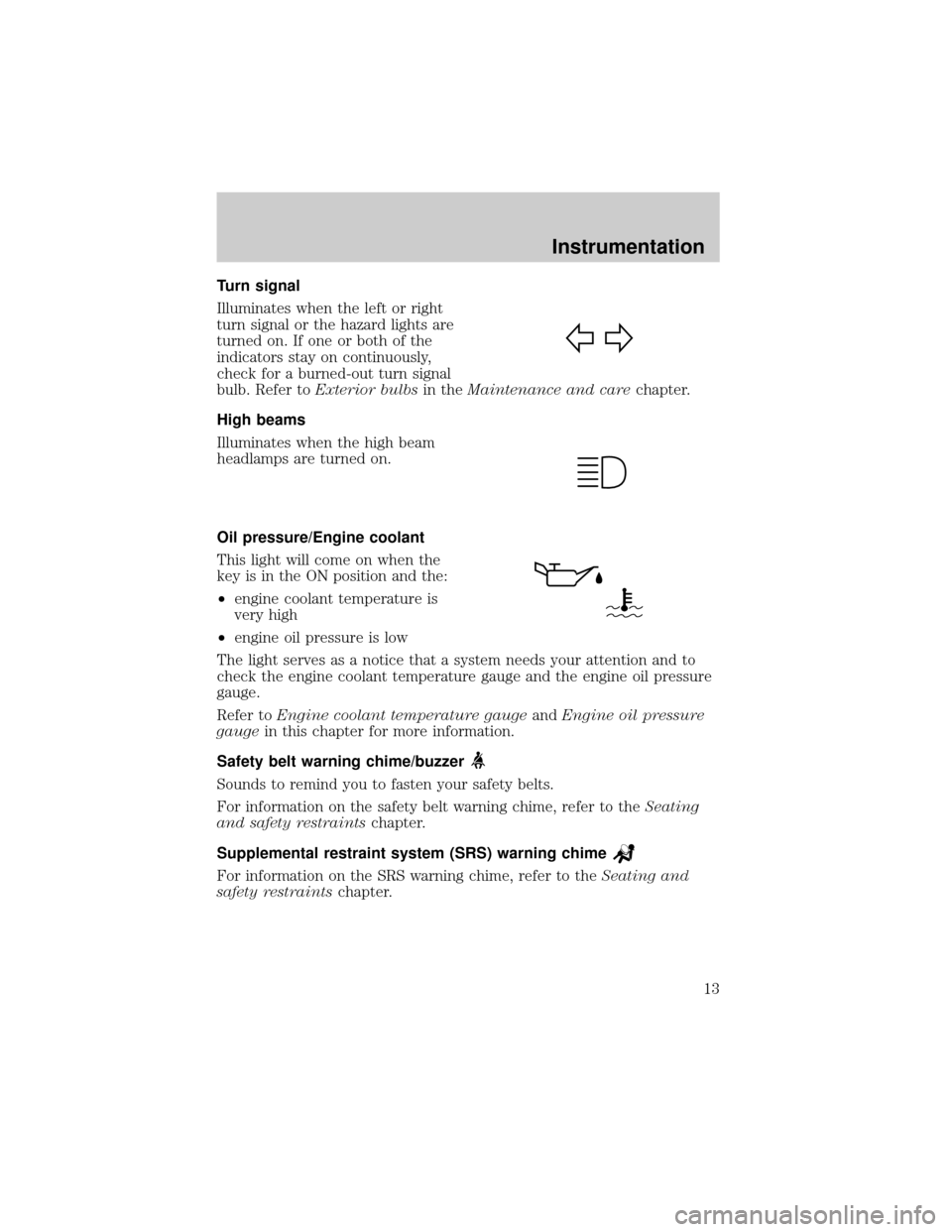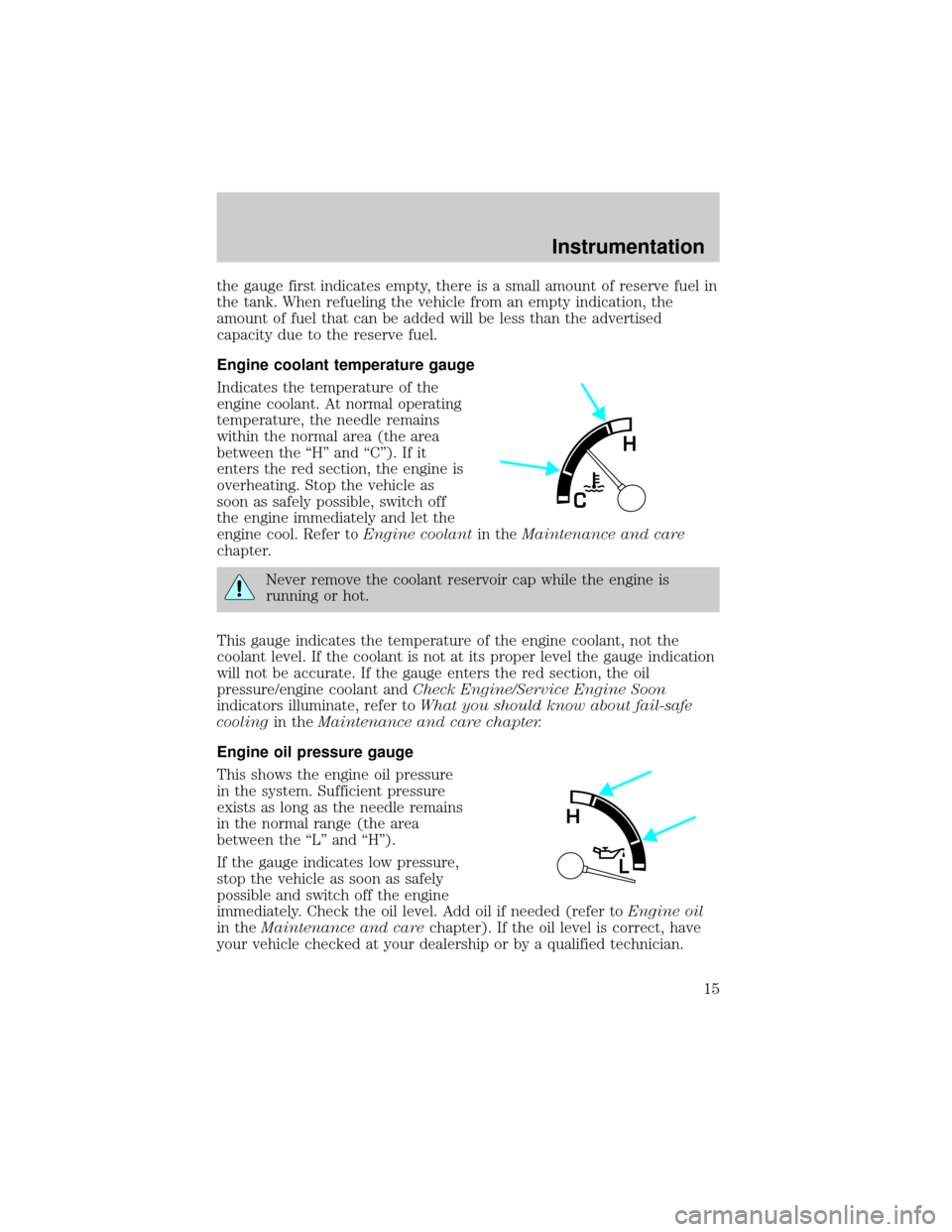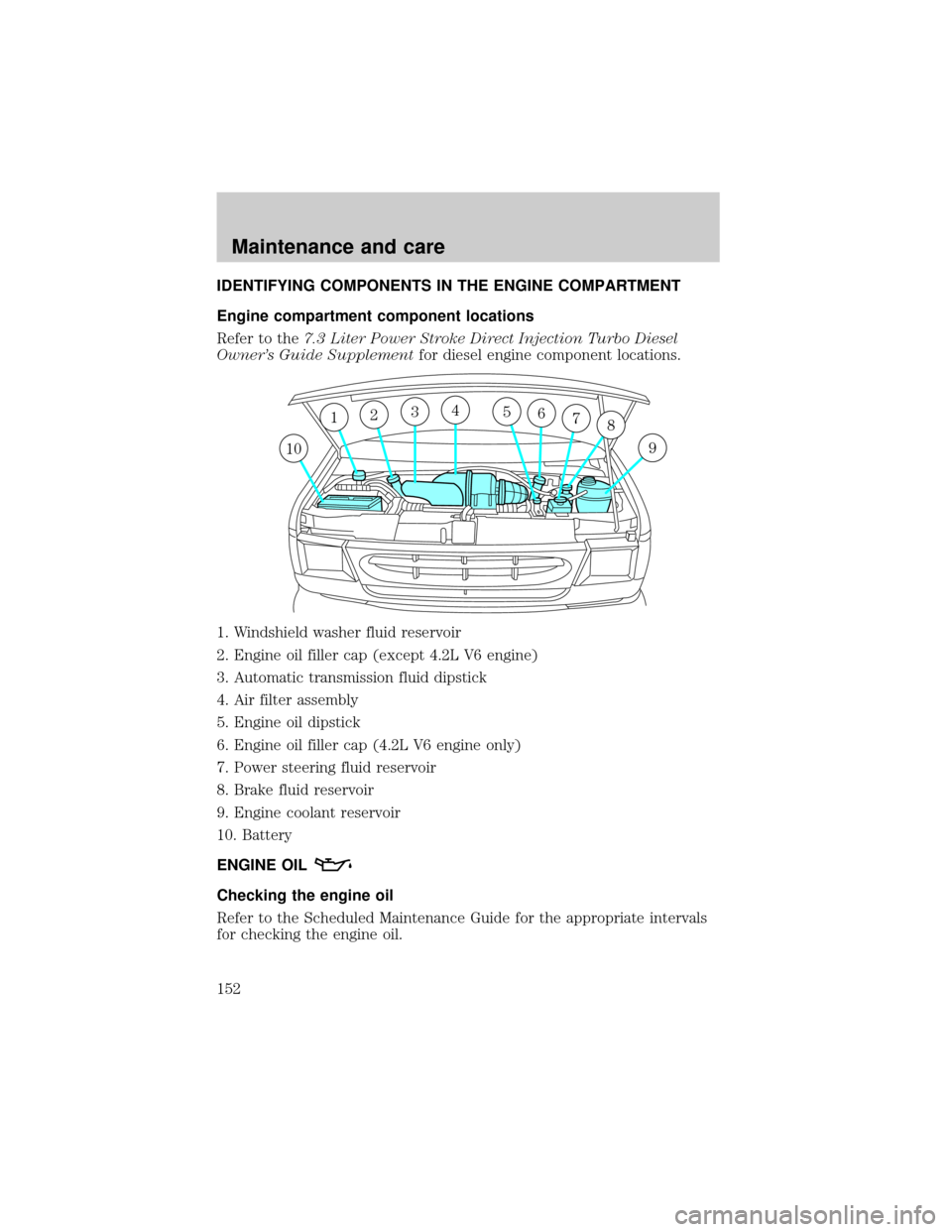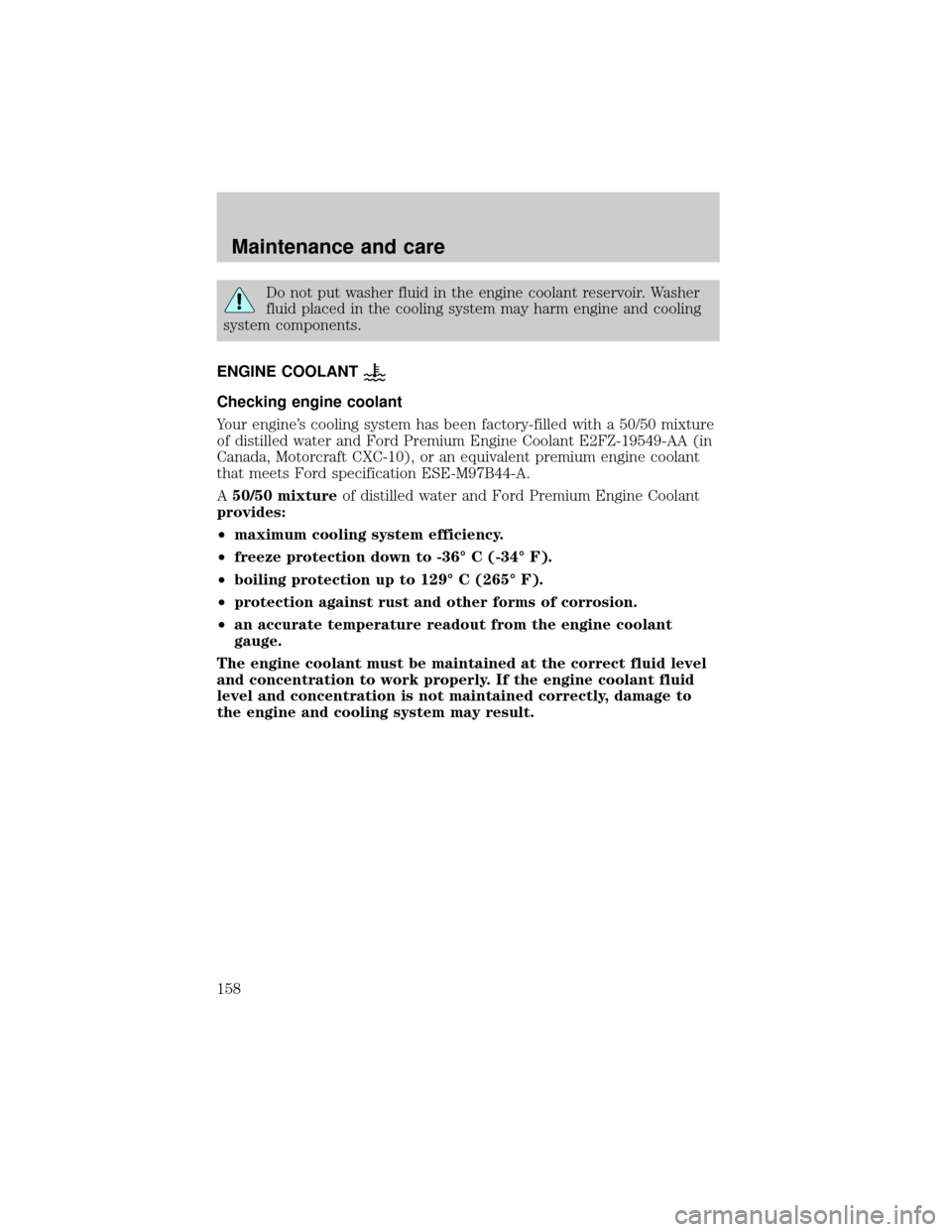check oil FORD E SERIES 2000 4.G Owners Manual
[x] Cancel search | Manufacturer: FORD, Model Year: 2000, Model line: E SERIES, Model: FORD E SERIES 2000 4.GPages: 232, PDF Size: 2.58 MB
Page 13 of 232

Turn signal
Illuminates when the left or right
turn signal or the hazard lights are
turned on. If one or both of the
indicators stay on continuously,
check for a burned-out turn signal
bulb. Refer toExterior bulbsin theMaintenance and carechapter.
High beams
Illuminates when the high beam
headlamps are turned on.
Oil pressure/Engine coolant
This light will come on when the
key is in the ON position and the:
²engine coolant temperature is
very high
²engine oil pressure is low
The light serves as a notice that a system needs your attention and to
check the engine coolant temperature gauge and the engine oil pressure
gauge.
Refer toEngine coolant temperature gaugeandEngine oil pressure
gaugein this chapter for more information.
Safety belt warning chime/buzzer
Sounds to remind you to fasten your safety belts.
For information on the safety belt warning chime, refer to theSeating
and safety restraintschapter.
Supplemental restraint system (SRS) warning chime
For information on the SRS warning chime, refer to theSeating and
safety restraintschapter.
Instrumentation
13
Page 15 of 232

the gauge first indicates empty, there is a small amount of reserve fuel in
the tank. When refueling the vehicle from an empty indication, the
amount of fuel that can be added will be less than the advertised
capacity due to the reserve fuel.
Engine coolant temperature gauge
Indicates the temperature of the
engine coolant. At normal operating
temperature, the needle remains
within the normal area (the area
between the ªHº and ªCº). If it
enters the red section, the engine is
overheating. Stop the vehicle as
soon as safely possible, switch off
the engine immediately and let the
engine cool. Refer toEngine coolantin theMaintenance and care
chapter.
Never remove the coolant reservoir cap while the engine is
running or hot.
This gauge indicates the temperature of the engine coolant, not the
coolant level. If the coolant is not at its proper level the gauge indication
will not be accurate. If the gauge enters the red section, the oil
pressure/engine coolant andCheck Engine/Service Engine Soon
indicators illuminate, refer toWhat you should know about fail-safe
coolingin theMaintenance and care chapter.
Engine oil pressure gauge
This shows the engine oil pressure
in the system. Sufficient pressure
exists as long as the needle remains
in the normal range (the area
between the ªLº and ªHº).
If the gauge indicates low pressure,
stop the vehicle as soon as safely
possible and switch off the engine
immediately. Check the oil level. Add oil if needed (refer toEngine oil
in theMaintenance and carechapter). If the oil level is correct, have
your vehicle checked at your dealership or by a qualified technician.
H
C
H
L
Instrumentation
15
Page 144 of 232

Model Bolt Size Wheel Lug nut Torque*
Nm Lb-ft
E-150 1/2-20 135 100
E-250, E-350 and
E-Super Duty9/16-18 190 140
* Torque specifications are for nut and bolt threads free of dirt and
rust. Do not use oil or grease on threads. Use only Ford recommended
replacement fasteners.
JUMP STARTING YOUR VEHICLE
The gases around the battery can explode if exposed to flames,
sparks, or lit cigarettes. An explosion could result in injury or
vehicle damage.
Do not push start your vehicle. You could damage the catalytic
converter.
Batteries contain sulfuric acid which can burn skin, eyes, and
clothing, if contacted.
Do not attempt to push start your vehicle. Automatic
transmissions do not have push-start capability.
Preparing your vehicle
1.Use only a 12±volt supply to start your vehicle.
2. Do not disconnect the battery of the disabled vehicle as this could
damage the vehicle's electrical system.
3. Park the booster vehicle close to the hood of the disabled vehicle
making sure the two vehiclesdo nottouch. Set the parking brake on
both vehicles and stay clear of the engine cooling fan and other moving
parts.
4. Check all battery terminals and remove any excessive corrosion before
you attach the battery cables. Ensure that vent caps are tight and level.
Roadside emergencies
144
Page 152 of 232

IDENTIFYING COMPONENTS IN THE ENGINE COMPARTMENT
Engine compartment component locations
Refer to the7.3 Liter Power Stroke Direct Injection Turbo Diesel
Owner's Guide Supplementfor diesel engine component locations.
1. Windshield washer fluid reservoir
2. Engine oil filler cap (except 4.2L V6 engine)
3. Automatic transmission fluid dipstick
4. Air filter assembly
5. Engine oil dipstick
6. Engine oil filler cap (4.2L V6 engine only)
7. Power steering fluid reservoir
8. Brake fluid reservoir
9. Engine coolant reservoir
10. Battery
ENGINE OIL
Checking the engine oil
Refer to the Scheduled Maintenance Guide for the appropriate intervals
for checking the engine oil.
12345678
910
Maintenance and care
152
Page 154 of 232

²Oil levels above the MAX mark may cause engine damage. Some oil
must be removed from the engine by a service technician.
7. Put the indicator back in and ensure it is fully seated.
Adding engine oil
1. Check the engine oil. For instructions, refer toChecking the engine
oilin this chapter.
2. If the engine oil level is not within the normal range, add only certified
engine oil of the recommended viscosity. Remove the engine oil filler cap
and use a funnel to pour the engine oil into the opening.
3. Recheck the engine oil level. Make sure the oil level is not above the
MAX mark on the engine oil level indicator (dipstick).
4. Install the indicator and ensure it is fully seated.
5. Fully install the engine oil filler cap by turning the filler cap clockwise
until three clicks can be heard.
To avoid possible oil loss, DO NOT operate the vehicle with the
engine oil level indicator and/or the engine oil filler cap removed.
Engine oil and filter recommendations
Look for this certification
trademark.
Use SAE 5W-30 motor oil certified for gasoline engines by the American
Petroleum Institute (API).
Motor oil displaying the API certification trademark will meet all
requirements for your vehicle's engine.
Ford oil specification is WSS-M2C153-G.
Do not use supplemental engine oil additives, oil treatments or engine
treatments. They are unnecessary and could, under certain conditions,
lead to engine damage which is not covered by your warranty.
Maintenance and care
154
Page 158 of 232

Do not put washer fluid in the engine coolant reservoir. Washer
fluid placed in the cooling system may harm engine and cooling
system components.
ENGINE COOLANT
Checking engine coolant
Your engine's cooling system has been factory-filled with a 50/50 mixture
of distilled water and Ford Premium Engine Coolant E2FZ-19549-AA (in
Canada, Motorcraft CXC-10), or an equivalent premium engine coolant
that meets Ford specification ESE-M97B44-A.
A50/50 mixtureof distilled water and Ford Premium Engine Coolant
provides:
²maximum cooling system efficiency.
²freeze protection down to -36É C (-34É F).
²boiling protection up to 129É C (265É F).
²protection against rust and other forms of corrosion.
²an accurate temperature readout from the engine coolant
gauge.
The engine coolant must be maintained at the correct fluid level
and concentration to work properly. If the engine coolant fluid
level and concentration is not maintained correctly, damage to
the engine and cooling system may result.
Maintenance and care
158
Page 185 of 232

Driving style Ð good driving and fuel economy habits
Give consideration to the lists that follow and you may be able to change
a number of variables and improve your fuel economy.
Habits
²Smooth, moderate operation can yield up to 10% savings in fuel.
²Steady speeds without stopping will usually give the best fuel
economy.
²Idling for long periods of time (greater than one minute) may waste
fuel.
²Anticipate stopping; slowing down may eliminate the need to stop.
²Sudden or hard accelerations may reduce fuel economy.
²Slow down gradually.
²Driving at reasonable speeds (traveling at 88 km/h [55 mph] uses 15%
less fuel than traveling at 105 km/h [65 mph]).
²Revving the engine before turning it off may reduce fuel economy.
²Using the air conditioner or defroster may reduce fuel economy.
²You may want to turn off the speed control in hilly terrain if
unnecessary shifting between third and fourth gear occurs.
Unnecessary shifting of this type could result in reduced fuel
economy.
²Warming up a vehicle on cold mornings is not required and may
reduce fuel economy.
²Resting your foot on the brake pedal while driving may reduce fuel
economy.
²Combine errands and minimize stop-and-go driving.
Maintenance
²Keep tires properly inflated and use only recommended size.
²Operating a vehicle with the wheels out of alignment will reduce fuel
economy.
²Use recommended engine oil. Refer toLubricant Specifications.
²Perform all regularly scheduled maintenance items. Follow the
recommended maintenance schedule and owner maintenance checks
found in your vehicle Scheduled Maintenance Guide.
Maintenance and care
185
Page 224 of 232

Customer Assistance ................127
Ford accessories
for your vehicle ......................217
Ford Extended
Service Plan ............................210
Getting assistance outside
the U.S. and Canada ..............216
Getting roadside assistance ...127
Getting the
service you need ....................210
Ordering additional
owner's literature ...................221
The Dispute
Settlement Board ...................213
Utilizing the Mediation/
Arbitration Program ...............216
Daytime running lamps
(see Lamps) ................................17
Dipstick
automatic
transmission fluid ...................165
engine oil .................................152
Doors
lubricant specifications ..........203
Driveline universal joint
and slip yoke .............................167
Driving under special
conditions
through water .........................126
Emergencies, roadside
jump-starting ..........................144
Emission control system ..........186
Engine ........................................206
check engine/
service engine soon light .........10
cleaning ...................................195
coolant .....................................158
diesel ...........................................5
fail-safe coolant ......................162
idle speed control ...................167
lubrication
specifications ...................203,206refill capacities ........................200
service points ..........................152
starting after a collision .........128
Engine block heater .................106
Engine oil ..................................152
checking and adding ..............152
dipstick ....................................152
filter, specifications .........154,199
recommendations ...................154
refill capacities ........................200
specifications ...................203,206
Exhaust fumes ..........................107
Fail safe cooling ........................162
Fluid capacities .........................200
Four-Wheel Drive vehicles
preparing to drive your
vehicle .....................................113
Fuel ............................................179
calculating fuel economy .......183
cap ...........................................182
capacity ...................................200
choosing the right fuel ...........181
comparisons with EPA fuel
economy estimates .................186
detergent in fuel .....................182
filling your vehicle
with fuel ....................179,182,183
filter, specifications .........183,199
fuel pump shut-off switch .....128
gauge .........................................14
improving fuel economy ........183
octane rating ....................181,206
quality ......................................181
running out of fuel .................182
safety information relating to
automotive fuels .....................179
Fuses ...................................130,131
Gas cap (see Fuel cap) ............182
Gas mileage
(see Fuel economy) .................183
Gauges .........................................14
battery voltage gauge ...............16
Index
224
Page 225 of 232

engine coolant
temperature gauge ...................15
engine oil pressure gauge ........15
fuel gauge ..................................14
odometer ...................................16
speedometer .............................14
trip odometer ............................16
GAWR
(Gross Axle Weight Rating) .....118
calculating ...............................120
definition .................................118
driving with a heavy load ......118
location ....................................118
GVWR (Gross
Vehicle Weight Rating) .............118
calculating ........................118,120
definition .................................118
driving with a heavy load ......118
location ....................................118
Hazard flashers .........................128
Headlamps ...................................17
aiming ......................................193
bulb specifications ..................193
daytime running lights .............17
flash to pass ..............................18
high beam ............................13,17
replacing bulbs ................188,190
turning on and off ....................17
warning chime ..........................14
Heating ........................................18
auxiliary heater and air
conditioner ................................23
heater only system ...................18
heating and
air conditioning system ............20
Hood ..........................................151
Ignition .......................................206
positions of the ignition ...........58
Infant seats (see Safety seats) ..95
Inspection/maintenance
(I/M) testing ..............................187Instrument panel
cleaning ...................................197
cluster .................................10,197
lighting up
panel and interior .....................18
location of components ............10
Jump-starting your vehicle ......144
Keys
key in ignition chime ...............14
positions of the ignition ...........58
Lamps
bulb replacement
specifications chart ................193
cargo lamps ...............................18
daytime running light ...............17
headlamps .................................17
headlamps, flash to pass ..........18
instrument panel, dimming .....18
interior lamps ...........................65
replacing bulbs ..188,190,191,192
Lane change indicator
(see Turn signal) ........................59
Lights, warning and indicator ....10
air bag ........................................12
anti-lock brakes (ABS) .....10,110
brake ..........................................10
charging system ........................12
check coolant ............................13
engine oil pressure ...................13
high beam .................................13
safety belt .................................12
service engine soon ..................10
turn signal indicator .................13
Load limits .................................118
GAWR ......................................118
GVWR ......................................118
trailer towing ..........................118
Loading instructions .................119
Lubricant specifications ....203,206
Lumbar support, seats ...............73
Mirrors
side view mirrors (power) .......67
Index
225
Page 226 of 232

Motorcraft parts .................183,199
Octane rating ............................181
Odometer .....................................16
Oil (see Engine oil) ..................152
Overdrive .....................................64
Panic alarm feature, remote
entry system ................................68
Parking brake ............................111
Parts (see Motorcraft parts) ....199
Power distribution box
(see Fuses) ...............................134
Power door locks ........................66
Power steering ..........................112
fluid, checking and adding ....164
fluid, refill capacity ................200
fluid, specifications ..........203,206
Preparing to
drive your vehicle .....................113
Radio ............................................25
Relays .................................130,137
Remote entry system ............67,68
illuminated entry ......................70
locking/unlocking doors ...........68
panic alarm ...............................68
replacement/additional
transmitters ...............................70
replacing the batteries .............69
Safety belts (see Safety
restraints) ................13,77,79,80,81
Safety defects, reporting ..........222
Safety restraints ...........77,79,80,81
belt minder ...............................84
cleaning the safety belts ...87,198
extension assembly ..................83
for adults .........................79,80,81
for children ..........................93,94
lap belt ......................................82
warning
light and chime ...............12,13,83
Safety seats for children ............95
Seat belts
(see Safety restraints) ...............77Seats ............................................71
child safety seats ......................95
Servicing your vehicle ..............150
Spark plugs,
specifications ......................199,206
Special notice ................................3
ambulance conversions ..............4
diesel-powered vehicles .............5
utility-type vehicles ....................3
Specification chart,
lubricants ............................203,206
Speed control ..............................59
Speedometer ...............................14
Starting your vehicle .........104,106
jump starting ..........................144
Steering wheel
tilting .........................................63
Tilt steering wheel ......................63
Tires ......................137,174,175,176
changing ...........................137,138
checking the pressure ............176
replacing ...........................140,177
rotating ....................................176
snow tires and chains ............178
tire grades ...............................175
treadwear ................................175
Towing ................................120,176
recreational towing .................126
trailer towing ..........................120
wrecker ....................................149
Traction-lok rear axle ...............113
Transmission .............................114
fluid, checking and adding
(automatic) .............................165
fluid, refill capacities ..............200
lubricant specifications ...203,206
Transmission
control indicator light .................12
Trip odometer .............................16
Turn signal .............................13,59
Vehicle dimensions ...................206
Index
226